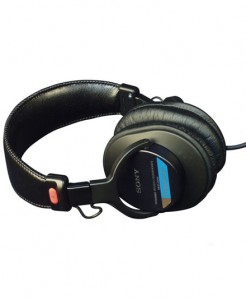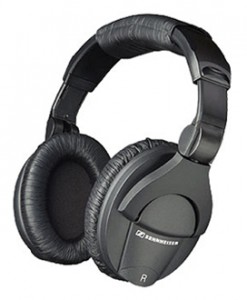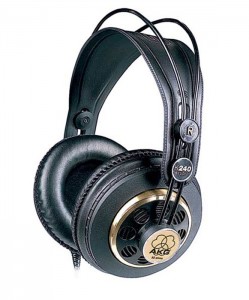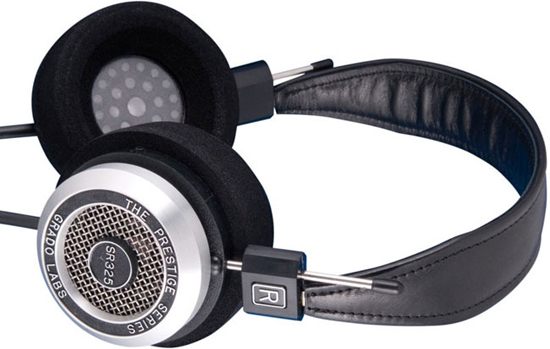A Guide to Popular Studio Headphones
Headphones are more popular now than ever before — and today’s music fans aren’t just listening on cheap earbuds, either. Although the consumer audio sector didn’t perform very well on the whole during the great recession, Hi-Fi headphones were the one category to boldly defy that trend. While the rest of the consumer sound market dropped by 14%, sales of headphones grew by 25% in the UK during 2011 alone.
But this growth hasn’t been limited to the number of sales. The average cost of headphones has been rising as well. In the US, sales of headphones priced over $100 have more than doubled, adding over $200 million in new revenue to the market. Unfortunately, some of us audio geeks may think that listeners’ priorities can be misplaced at times. 54% of consumers said that the “brand” of headphones was “very important” in their choice, while only 48% said the same for “sound quality.”
But before we get all high and mighty, let’s take a look at what headphones we’ve been listening on in the studio, and then evaluate where they serve us well — and where they don’t. Because today, having a reliable headphone reference may be more important than ever.
Sony MDR-7506 ($99)
Pros: They’re hard to break, they’re loud, and they’re everywhere.
Cons: Extremely quirky frequency response; Have been out-classed by many new models.
Everyone who knows audio knows the MDR-7506 headphones. They are quite possibly one of the most ubiqutous models of headphones of all time. They’re loud and hard to break, and the 7506’s rugged closed-back design make them a sensible choice for the tracking room floor, intensive day-to-day handling and live sound applications.
On the other hand, the MDR-7506 headphones are not without their quirks. How can you tell if your mix sounds right on these Sonys? Well, if it strikes you as too bright, too brash and too boomy, you’re probably headed in the right direction.
In the interest of sounding loud and exciting, the 7506s are unusually bright headphones, with a frequency response somewhere between a smiley face and a roller-coaster. This may help them overcome the “boxiness” of older closed-back designs in order to easily win audio “sip-tests”, but it doesn’t mean they’re an ideal choice for all users.
For some listeners, this hyped-up response may sound refreshing over short periods of time. The unfortunate flip side is that these headphones can become grating over long listening stretches. In any event, their hyped-up sound doesn’t stack the deck in your favor when it comes to making smart choices about EQ and frequency balance.
Related models:
The larger, more expensive MDR-7509 can sound a bit bigger in the lows and smoother on top than the MDR-7506, but still have a frequency response of Appalachian proportions. The smaller, more affordable MDR-7502 may be a little brighter than what some other brands of headphones have to offer, but they might sound the most neutral of this series – although perhaps not the most impressive.
Sennheiser HD-280 Pro ($99)
Pros: Hard to break, great isolation, un-hyped sound.
Cons: Lacks the benefits of more expensive open-back designs; Not ideal for mixing or critical listening.
The Sennheiser HD-280 Pro headphones are now established as one of the rising stars of a newer generation of headphone designs.
They can handle a lot of abuse, and their extremely well-insulated closed-back design reduces bleed and cuts out significant levels of outside noise. This makes the HD-280 an exceptional choice for tracking sessions, and its acoustic-isolation properties are especially useful in live sound applications.
Although the HD-280 headphones may be one of the best tracking models available for under $100, they’re not without their limitations. Since the HD-280 lacks the uncolored performance of more expensive open-back headphones, so they’re not recommended for critical listening decisions or as a mix reference.
Additionally, some singers can find the isolating effect of well-insulated headphones to be confusing, and the old “removing one headphone” trick can be necessary more often than not with this type of design.
Related models:
Sennheiser’s HD-380 Pro are a nice step up for $199 and Audio-Technica’s ATH-M50 are also good value at $159.
AKG K240 Studio ($99)
Pros: Affordable, comfortable open-back design delivers neutral frequency response.
Cons: Larger than many other studio headphones; Wire-to-body connection may not be rugged enough for heavy-handling situations; Open-back means more headphone bleed (in both directions).
The AKG K 240 is one of the modern classics of high-quality headphones. Of all the models we’ve listed here so far, they’re easily the most un-hyped and reliable from a critical-listening standpoint.
The one drawback is that although the open-back design of these headphones allows for a better frequency response, it also means more sound can get in and out. Headphones in this class are ill-suited for live sound scenarios and for tracking sessions that involve loud bands.
Some singers, however, may enjoy the relative lack of acoustic isolation the K240 provides, and this style of headphone can sometimes help improve pitch issues without the need to remove one ear-cup. If you don’t mind a smidge of headphone bleed in the mic, they can be terrific in this application.
Related models:
An updated version, K 240 MK II, is also available for $199.
Grado Labs SR-325is ($295) & RS2i ($495)
Pros: Neutral, durable, compact open-back design ideal for critical listening; Made locally in Brooklyn, NY by a classic and committed family-owned business.
Cons: Fairly expensive; Not ideally suited for tracking or live sound applications.
When you put on a good pair of Grado headphones, don’t expect to be blown away by their sound. Instead, expect not to hear them at all. That’s the beauty of all of Grado’s best designs. They stand aside and allow you a direct link to your music.
Although the SR-325is and RS 2i are not technically part of Grado’s “Professional Series” (The PS-500 and PS-1000 sell for $600 and $1,000, respectively) they are a great set, and would make a near-ideal headphone reference for most engineers and musicians.
Related models:
The entire Grado line is worth investigating, and they offer superb models that run from $79 on up to $1,700.
In this general price range, open-backed models from AKG like the K701 and K702 (both $349) are also worth a look, as are their closed-back K271 MKII ($269) which are suitable for tracking and live sound as well.
The open-back Sennheiser HD-600 and HD-650 headphones are available at the price of $399 and $479 respectively, and stand among some of the best pro audio headphones ever made.
Please note: When you buy products through links on this page, we may earn an affiliate commission.











Adam / Mr. Fantastic
June 8, 2012 at 7:07 am (13 years ago)If you want a great set of headphones, try the Audio-Technica ATH-M50’s. Some of the top mixers even mix using these! Under $150. — Adam / Mr. Fantastic
David Prouty
June 8, 2012 at 9:13 am (13 years ago)KRK KNS-8400 is not a horrible choice. If I am mixing in headphones (Hopefully not) I prefer these to almost all except for the Sennheiser HD-600 and HD-650.
Freelance Audio Engineer Bart
June 11, 2012 at 1:37 pm (13 years ago)For tracking purposes, the Sennheiser HD 280’s have stood the test of time. I like the modular design. You can easily replace the pads when they wear out. I also recently got a pair of HD 650’s after a lot of critical listening against various AKG’s Denons, Beyers, ect. I really like them.
Leo
June 12, 2012 at 4:19 pm (13 years ago)I second the KRK KNS-84000 comment. Wearing a pair right now. Comfortable, natural response. One thing I don’t like about them is the non-coiled cable.
Domain Admin
June 18, 2012 at 3:42 pm (13 years ago)Gotta say, every studio I’ve used 7506’s in has a pile of them with the right driver blown. They’re expensive to fix and it seems to be a common problem with that one going out. Love the 650’s and I gotta say, the 800’s are even better.
For day to day use my vote goes for the ATH-M50’s as Adam’s mentioned, they sound great and can take a LOT of abuse
PostProductionsAudio
June 20, 2012 at 10:30 pm (13 years ago)Coming from a NYC apartment with not enough space for studio monitors, I purchased several pairs of headphones over the past few years, including Sennheiser HD580, HD600, AKG K271 MKII, Sony MDR-7506. The Sennheisers are my favorite for classical recording, editing and mastering, while I make heavy use of the 7506s for live sound. True they’re not much of a good mix reference (IMO only the speakers in the venue are), but they’re damn near perfect to check something on one ear, for example. The AKGs isolate well but I’ve never acclimated to their tonal balance.
I agree with everything you’ve mentioned except that Grado headphones sound neutral. I like their sound, but find them quite bright in the high end especially compared to Sennheiser HD600 and 580 (the plastic version of the 600s). In the world of classical recording there seem to be two camps – Sennheiser people and Grado people. Clearly I’m the latter. Anyway, great article.
Torley
July 2, 2012 at 4:38 pm (13 years ago)Thanks for the roundup; I came here via http://bit.ly/Np4BSr
I’ve used several of the aforementioned pairs over the years. Despite the astoundingly consistent Amazon 5-star reviews, I couldn’t acclimate to the ATH-M50 at all. This is likely due to me being hearing-impaired (tinnitus, hyperacusis) and having a variant grasp of the frequently spectrum.
I propose an unconventional choice.
My fave cans by far — and worthy successor to the other MDRs — are the Sony MDR-XB700s. I use them for all stages in the audio production pipeline, including mastering. You can find a refurb pair for a touch under US$80 (!). New prices have dropped to under US$100 since they were restocked a couple months ago.
The XB700s have superior, deep (but not bloated) bass response that can’t be touched by far pricier headphones, crisp-yet-not-shrill trebles, and a warm midrange is how I’d characterize them. Soft on the ears with their big pillow “Princess Leia” cushions, altho they can’t be folded. They do have a nice carry bag.
They aren’t intended to be clinically accurate, but whether I’m consuming or creating a spectrum of music (everything from Renaissance chant to deathcorestep metal), they’re an amazing bang for the buck.